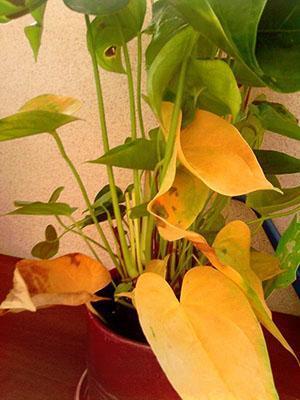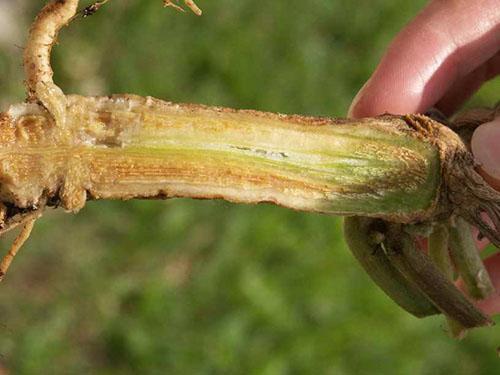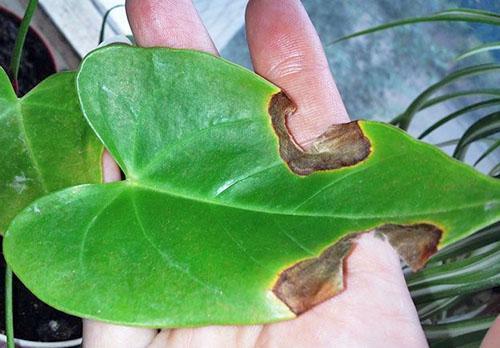How to prevent anthurium diseases
 The indoor flowers that people from distant countries serve are beautiful, but they are slaves who were placed in a cramped pot and a different climate. Can a plant thrive in conditions alien to it? Only imitation of the native climate allows you to get a healthy, beautiful flower. At the slightest deviation from normal conditions of detention, anthurium diseases arise. At the first changes in the type of bush, it is necessary to analyze the conditions of detention.
The indoor flowers that people from distant countries serve are beautiful, but they are slaves who were placed in a cramped pot and a different climate. Can a plant thrive in conditions alien to it? Only imitation of the native climate allows you to get a healthy, beautiful flower. At the slightest deviation from normal conditions of detention, anthurium diseases arise. At the first changes in the type of bush, it is necessary to analyze the conditions of detention.
Diseases of anthurium at home
A healthy flower captivates with its beauty. The condition of the plant can suddenly change. Any diseases arise for reasons:
- non-compliance with the requirements of agricultural technology;
- infectious diseases;
- insect pests brought in from the outside.

There are people who basically do not keep animals and flowers in their living quarters. They believe that the zoo and indoor maintenance are violence against wildlife. A bouquet of fresh flowers is unacceptable for them, one cannot rejoice at the ruined life, even if it is plants.
Read also the article: myrtle flower home care photo!
 Non-infectious plant diseases are associated with the appearance of spots on the leaves, their discoloration, or growth retardation. Sometimes brown spots or mildew on the neck of the plant become visible. What to do if spots appear on the anthurium? A lot can be learned by the nature of the deformation:
Non-infectious plant diseases are associated with the appearance of spots on the leaves, their discoloration, or growth retardation. Sometimes brown spots or mildew on the neck of the plant become visible. What to do if spots appear on the anthurium? A lot can be learned by the nature of the deformation:
- If dark dots appear on the leaves of anthurium, gradually expanding, it is cold. The same spots can appear from sunburn when the summer sun comes into direct contact with leaves.
- The reason for the appearance of stains can be irrigation with unsteady water or water of increased hardness. If scale forms on the teapot over time, this is a sign of stiffness. Such water must be defended for a long time before watering or passed through a softener filter. Another way, mainly for rural areas with hard water from wells, is incomplete freezing of water in a tank. In this case, the ice will have a lower salt content than the remaining water.
- Other physiological reasons for the appearance of dark spots and drying of the plate from the edge can be drafts and low temperatures in winter. Abundant watering is also accompanied by a signal of dark dots on the leaves. What to do if spots appear on the anthurium? Remove provoking reasons and patiently wait for the results.
- Yellow or pale leaves of plants or spots of this color indicate that there is not enough light for the anthurium. In addition, this can be a signal that the roots are sick and do not provide food for the plant.
- The general pallor of the leaves signals a lack of nutrition. The same is indicated by the absence or weak growth of the plant, the absence of flowering. If the plant has been transplanted recently, then it needs feeding. Sometimes it is better to transplant the plant. At the same time, prepare the desired composition of the substrate or buy ready-made soil. Disinfection of the soil and planting pot is necessary.
- If the irrigation regime is violated and the roots of the anthurium have rotted, then this will affect the yellowing and drying of the leaves, the brown neck of the anthurium, possibly mold. The plant needs urgent resuscitation. In this case, all affected parts must be removed and the wounds must be sprinkled with an antiseptic, crushed charcoal, cinnamon powder or wood ash.
 Diseases of the leaves of anthurium in the photo show characteristic damage, but often the help of specialists is required to accurately determine the disease. Drafts are detrimental to the plant. This is especially dangerous in winter. Insufficient humidity in the surrounding air is the answer to the question of why the leaves of the anthurium dry. On the other hand, leaves can die off naturally due to aging. If the leaves are curled into a tube, remove the anthurium deep into the room, the light is too bright, he closed his eyes.
Diseases of the leaves of anthurium in the photo show characteristic damage, but often the help of specialists is required to accurately determine the disease. Drafts are detrimental to the plant. This is especially dangerous in winter. Insufficient humidity in the surrounding air is the answer to the question of why the leaves of the anthurium dry. On the other hand, leaves can die off naturally due to aging. If the leaves are curled into a tube, remove the anthurium deep into the room, the light is too bright, he closed his eyes.
Infectious diseases of anthurium include problems caused by the introduction of spores and microbes into the body of a flower. The difference between these diseases is that they can destroy the entire home green world if not dealt with. Spores are transmitted and multiplied quickly in cramped conditions.
 The root causes of disease depend on the grower. The brought shoot, taken from a diseased plant, may already harbor viruses, for which there are no effective remedies yet. They affect the vascular system. And the infection can be transmitted through a dirty tool or insects. The acquired plant must be quarantined for two weeks, isolated from other plants. And only then move into the general composition.
The root causes of disease depend on the grower. The brought shoot, taken from a diseased plant, may already harbor viruses, for which there are no effective remedies yet. They affect the vascular system. And the infection can be transmitted through a dirty tool or insects. The acquired plant must be quarantined for two weeks, isolated from other plants. And only then move into the general composition.
A purchased or independently compiled earthen mixture should be heat treated, spilled with hot strong potassium permanganate, you need to add crushed charcoal, a long-acting drug from rot "Glyocladin". It will protect the roots from late blight, fusarium and similar diseases. Competent care of anthurium - barrier diseases.
 Diseases that are transmitted to anthurium from the external environment can be:
Diseases that are transmitted to anthurium from the external environment can be:
- septoriasis;
- anthracosis;
- fusarium wilting;
- rust.
The causative agent of septoria, Septoria fungus spreads in a humid and warm atmosphere. The characteristic brown spots with a yellow rim on the leaves signal anthurium disease. The leaf dries up; when watering, the spores move to other parts of the plant. The plant will die if it is not treated in time with copper-containing fungicides.
Anthracosis is a very common disease called powdery mildew. The disease is caused by the fungus Colletorichum. The spread of this disease will lead to quick drying of the leaves, stems and root system. Anthracosis begins on the leaf blades, the appearance of brown spots with black dots in the center. This is controversy. They scatter and germinate when moistened, and for the atrium this event is vital.
 Atrium care for septoria disease consists in reducing watering and spraying with the addition of copper fungicides. The soil is treated with Abiga-Peak. If the plant cannot be cured, it should be destroyed by burning. The ceramic pot needs to be well calcined. Dishes that cannot be burned must be destroyed.
Atrium care for septoria disease consists in reducing watering and spraying with the addition of copper fungicides. The soil is treated with Abiga-Peak. If the plant cannot be cured, it should be destroyed by burning. The ceramic pot needs to be well calcined. Dishes that cannot be burned must be destroyed.
If the plant is infected with rust, then orange loose pads on the leaves will be visible. Such a plant should be wiped with a fungicide solution, but not sprayed so as not to infect healthy leaves. It is better to burn diseased infected leaves.
 Fusarium wilting is a formidable disease of anthurium at home. It affects all plants, affecting the root system and leaves. The signs are the sudden wilting of the entire bush. The first signs may be unnatural bending of the peduncles, strong and rapid yellowing of the foliage. Copper preparations, soil treatment with glyocladin are suitable for the fight. The best way would be to wash the plant from all particles of soil, soak it in a weak solution of foundationol for a little, cut off the affected parts and plant in a new dish. Old soil and plant debris must be destroyed.
Fusarium wilting is a formidable disease of anthurium at home. It affects all plants, affecting the root system and leaves. The signs are the sudden wilting of the entire bush. The first signs may be unnatural bending of the peduncles, strong and rapid yellowing of the foliage. Copper preparations, soil treatment with glyocladin are suitable for the fight. The best way would be to wash the plant from all particles of soil, soak it in a weak solution of foundationol for a little, cut off the affected parts and plant in a new dish. Old soil and plant debris must be destroyed.
Anthurium insect pests
 Insects common on home flowers include:
Insects common on home flowers include:
- aphid;
- thrips;
- shield;
- spider mite;
- root nematodes.
They all suck the juice from the plant, depriving it of nutrition. At the same time, signs of the presence of pests can be found during hygiene procedures that are regularly carried out with good care.
Help, what's wrong with my anthurium?
Such dry spots and holes on the leaves are a manifestation of a fungal disease. Change the soil, inspect the roots, if there are rotten ones, cut them off. The affected leaf is also. Treat with fungicide.
Thanks Olya, but is it really possible to replant in winter?
If you are sick, then it is not only possible, but also necessary. Otherwise, if you wait until spring, there is a risk of losing the flower altogether.
Thanks Olya
Good evening! Does it make sense to save and how? Thank!
I think it's worth a try, because there are good live roots. Cut off anything that is rotten, both roots and petioles. The green, intact remnants of the petioles can be left, but the top cut can be renewed. Treat what is left with a fungicide, and sprinkle the cuts with charcoal and dry. Root the plants in light soil, preferably in a greenhouse (you can cover with a cut bottle). If you're lucky, new leaves should appear.
Thank! I will try!
And yet, in three months I have not yet understood the secret! Expanded clay to the bottom. Earth: coconut + bark + sphagnum + coal + perlite + orchid substrate. Watering once a week. There is enough light. Neon lights. Fertilizer for orchids. I spray every day. Almost all have rotted ...
If not difficult, write in your opinion the ideal primer for anthurium. To understand exactly how many parts should be of which element! Thank!
You can find out in detail what kind of soil anthurium needs here https://myvilla.cosmetius.com/en/pravilnyy-grunt-zalog-zdorovogo-razvitiya-anturiuma/ ... Or maybe you sprayed them too often? Or are the plants already sick?
Hello! Anthurium started having such problems with leaves
It looks like rust. Treat the flower with Topaz for 2 weeks, rubbing the leaves with a solution every 3 days. It is impossible to spray yet.
Hello! What to do and how to treat the problem with leaves in anthurium?
Thanks for the quick response! Tell me whether to wipe all the leaves or only the diseased ones, in what proportion to dilute. Is it possible to replace Topaz with Fundazol, because there is Fundazol, but there is no Topaz. If so, in what proportion to dilute.
I myself have not come across such a byaka, I will not say anything from my personal practice. But on one of the sites where the treatment of orchids was discussed, I found information that Fundazol is not suitable against rust. You can look for Skor instead of Topaz - it will also help. I would cut off diseased leaves altogether - they will no longer recover, and the rest can still be saved by wiping. A transplant can also be done - at the same time, check if everything is in order with the roots.
And another question, is it necessary to transplant into another substrate?
Thank you so much! I will treat.
Hello, tell me what's wrong with my anthurium. For more than a year on the leaves, such dots squeezed out from the inside out, lined up in lines, the color has not changed. Now it has completely stopped blooming. I can't find a similar description anywhere. Do you know what it is?
On one of the forums I found information what this could be if the flower is cold or a constant excess of moisture. Adjust watering, move to a warmer room. Do you see any pests? I would also spill Aktara for prevention.
Thanks, I'll try
Hello, please help save the flower. I bought anthurium 2 months ago, transplanted it right away.2 months no changes or signs of growth. It seemed to me that the land bought specifically for the anthurium was of poor quality. There was no bark, sphagnum, nothing. Recently I decided to make the soil myself. I bought bark, sphagnum, mixed with earth, everything as advised. A couple of days ago, the leaves began to dry and some strange light spots appear on them, which grow. I treated it with phytosporin, but the process did not stop. What could be with a flower?
Submitting another photo with strange light spots.
And further
Try replacing the biofungicide with a chemical one like Topaz. And I would still look for a special store substrate for anthurium. Perhaps, when compiling the soil, some kind of byaka got into or the proportions were violated.
I bought a sick plant right away: the leaves are twisted, the brown spots look like scab. I transplanted it into my soil. But this is not enough, the patient knocked out a young leaf again !! How to spray? Not visible in the photo, but besides the brown thing, there are cobwebs!
If there is a spider web, it is definitely a spider mite. And the "brown thing" is places, bite marks, where insects have already drunk their juice. It is almost impossible to see ticks, they are so small, they are identified mainly by the presence of a cobweb. But they do colossal harm. Isolate the flower to prevent pests from scattering throughout your room collection. Since ticks have already taken a fancy to the plant, one cannot do without treatment with special preparations. Fitoverm, Aktofit, Kleschevit are suitable - these are biological products, they are convenient and can be used at home. With the prepared solution, wipe all the leaves on both sides and spray more on top. Perform 2-3 treatments with a break of 10 days.
Good day. Please tell me why the leaf of the anthurium turned yellow? Watering and conditions have not changed.
The appearance of yellow spots is most often from violations of the irrigation regime. But if nothing has changed, I would check the roots and change the soil at the same time. For prevention, you can treat it with a fungicide and observe how the flower will behave further. The leaf with spots must be cut off.